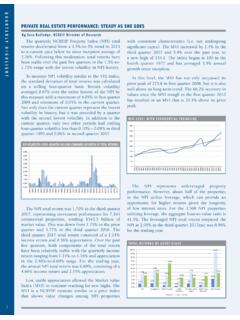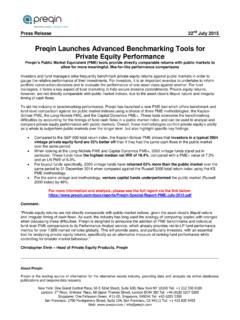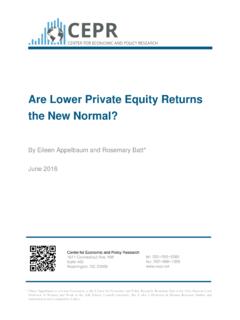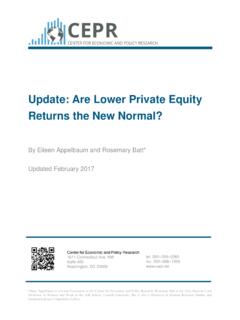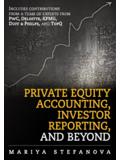Transcription of The “Missing Link” in Benchmarking Private Equity ...
1 The Journal of performance MeasurementWinter 2017/2018-8-The Missing Link in Benchmarking Private Equity performance and a New Twist on Alpha Over the past twenty plus years, various quantitative methodologies have been developed to facilitate comparisonsbetween Private Equity fund internal rates of return (PEF IRR), and public market benchmark time-weighted ratesof return (TWR). Long and Nickels (1996) got the Private Equity Benchmarking ball rolling when they introducedthe Index Comparison Method, later renamed Public Market Equivalents (LN-PME). This method invests the pri-vate Equity fund s investor cash flows in the public market benchmark to calculate a public market equivalent IRR(PME IRR). The over or underperformance (IRR spread) is the PEF IRR minus the PME IRR. Unfortunately, po-tential disparities in Private and public market performance present challenges for the LN-PME method. Sincethen, there have been proposed methods to correct for the Private and public market performance differences;however, they use heuristic approaches and have additional mathematical difficulties.
2 Two promising methodswere introduced in 2014. Gredil, Griffiths, and Stucke s (2014) Direct Alpha method extended the Kaplan andSchoar (2005) Private market multiple method. Global Endowment Management s (2014) GEM IPP method ex-panded Philappaou and Gottschalg s (2005) excess IRR method. Both Direct Alpha and GEM IPP calculate theIRR spread using a benchmark return plus a market premium model. All methods assume the IRR spread isarithmetic and each produces different results. Until now, no method has been capable of identifying the impliedcash flows and the related PME IRR. As a result, it is impossible to know which method is correct or the most ac-curate. This article solves the dilemma, provides a solution and the missing link for Private Equity is now possible to identify the correct IRR spread as well as the public market equivalent portfolio implied cashflows and the related PME D AlessandroDirector of Real Estate performance Measurement for the National Council of Real Estate Investment Fiduciaries(NCREIF), is primarily responsible for fund index and attribution products, including governance and complianceprograms.
3 Prior to joining NCREIF in 2015, Mr. D Alessandro was President of D Alessandro Associates, Inc.,providing accounting, reporting, analysis, performance measurement, Benchmarking , and systems consulting toinstitutional real estate investors and managers for 15 years. Mr. D Alessandro has been instrumental in devel-oping the industry s first fund indices and attribution products for NCREIF. He frequently teaches seminars, con-ducts webinars, and publishes articles on Real Estate performance Measurement and Reporting. He is an activemember of NCREIF s performance Measurement and Education Committees, as well as the Global InvestmentPerformance Standards United States Investment performance Committee (GIPS USIPC). Previously, Mr. D A-lessandro served as the chairperson of the GIPS Real Estate Working Group and the NCREIF performance Meas-urement Committee. Earlier in his career, he was a Principal with Lend Lease Real Estate Investments and anAudit Manager with Touche Ross & Co.
4 He is a CPA, a graduate of Hofstra University, New York, and currentlyresides in Eatonton, the past twenty plus years, various quantitativemethodologies have been developed to facilitate com-parisons between Private Equity fund (PEF) perform-ance and an index or a benchmark (sometimes referredto as the reference or replicating portfolio). Such refer-ence portfolios typically are based upon publicly avail-able indices or benchmarks ( , public marketequivalent); however, for certain asset classes and vehi-cle structures, such as open-end core real estate, privatemarket indices and benchmarks also can be utilized,with the chosen index or benchmark typically dependentupon the investment style of the PEF under this reason, as used herein, the acronym PME ismore broadly defined than usual as either a public or pri-vate market reasons for multiple methods of comparing privateto public market (or Private to Private market) perform-ance is simple we are dealing with complex math com-pounded by the unique nature of privately-heldThe Journal of performance MeasurementWinter 2017/2018-9-closed-end vehicle investments.
5 Private Equity relies ex-tensively on the internal rate of return (IRR) as a report-ing metric, whereas public Equity and open-end core realestate use the time-weighted rate of return (TWR). Sincethe IRR considers the timing of cash flows and privateequity managers have control of investor capital callsand distributions, the IRR is a better measure of man-ager performance . In contrast, public Equity and open-end real estate fund managers do not control the timingof investor cash flows, therefore, the TWR, which neu-tralizes the timing of cash flows, is a better measure ofmanager IRR and TWR metricsare vastly different, comparing the two proves im-mensely challenging and frequently yields limited usefulresults. The need to compare the two is clear and present investors, investment managers and consultants mustevaluate whether Private Equity investments performedbetter, the same or worse than alternative and Nickels (1996) developed the Long-NickelsIndex Comparison Method, or Public Market Equivalent(LN-ICM or LN-PME), which is often credited as thefirst method to formally evaluate Private Equity perform-ance.
6 In this method, the Private Equity cash flows ( ,investor contributions and distributions) are assumed tobe invested in a PME using the exact timing andamounts of the PEF cash flows under analysis. The onlydifference in the cash flow streams between the PEF andthe PME is the ending net asset value (NAV), which forthe PME is the terminal value of the assumed cash flowsas if they were invested in the PME. The PEF IRR isthen compared to the PME IRR and the difference is theover or underperformance (or the IRR Spread) of thePEF relative to the PME. While this initially sounds veryintuitive and easy to implement, LN-ICM has certainchallenges when performance significantly diverges be-tween the PEF and PME. For example, strong positiveperformance by the PEF may result in large distributionsthat, when applied to the PME during a period of weakperformance, could result in large negative market val-ues or short positions in the PME, thereby rendering theassumed PME returns unreliable for comparative pur-poses.
7 Conversely, the opposite may happen in a marketscenario where very weak PEF performance is mis-matched against strong PME performance , resulting inlarge long positions in the PME in later years. Despitethe potential mismatch under certain market conditions,LN-ICM got the Benchmarking ball rolling for the pri-vate Equity industry due to the method s intuitivenessand ease of implementation and, in fact, is still beingused and Capital Dynamics (2003) developed thePME plus (PME+) method. PME+ attempts to rectifythe potential for short and long positions in the PMEunder LN-ICM by adjusting the assumed distributionsby a fixed scaling factor so that the ending NAV of thePME is the same as the PEF. Unfortunately, making ad-justments to the interim cash flows in order to force theending NAV to be the same between the PME and PEFhas unintended impacts on the IRR, making compar-isons even more suspect. Kaplan and Schoar (2005) created the KS-PME method,which advanced the choices through the introduction ofa market multiple similar to the total value to paid in(capital) multiple (TVPI) but using compounded futurevalues (or discounted present values) instead of the ac-tual cash , KS-PME future values thedistributions and ending NAV; then divides such by thefuture value of the contributions.
8 The future values ofthe contributions and distributions are based on the pe-riodic returns of the PME. The KS-PME multiple thenis compared to the PEF TVPI and the difference, or mul-tiplier, is the over or underperformance. The benefits ofthis method are that it is cash flow-based, uses a well-known metric in the Private Equity industry, and is de-rived from the Modern Portfolio Theory (MPT) modelfor expected returns, which consists of both market andnon-market return contributions. The disadvantages ofKS-PME are that the multiple is neither a return nor re-turn spread and cannot be used in MPT modeling, absentother significant and Gottschalg (2005) wrote a paper describ-ing alpha or excess IRR that was then described inmore detail by Global Endowment Management (2014)as GEM Implied Private Premium (GEM IPP). TheGEM IPP is calculated by solving for the IRR Spread or market premium that when added to the benchmarkreturns provides the required rate of return such that thefuture value of the cash distributions equals the futurevalue of the cash contributions.
9 This is similar to an IRRcalculation that discounts cash flows to a net presentvalue of zero, or compounds cash flows to a net futureThe Journal of performance MeasurementWinter 2017/2018-10-value of zero. Stated another way, under the GEM IPPmethod, when the net present or future value of cashflows equals zero, the TVPI based on those values willequal one, resulting in an indifference point between thePEF and PME. The drawback of this method is that thePME portfolio cannot be formalized or replicated. Therefore, the PME IRR can only be implied as the dif-ference between the PEF IRR and the GEM Associates (2013) created a method calledmodified PME (mPME). mPME is similar to PME+, butinstead of using a fixed scaling factor for all distribu-tions, it uses a time-varying scaling factor based on in-terim Private Equity NAVs. This method has challengesnot only from the alteration of cash flows as in PME+,but also introduces another potential bias relating to un-reliable pricing of interim Private Equity Direct Alpha (DA) method was created by Gredil,Griffiths and Stucke (2014).
10 DA is deduced from KS-PME by computing the future value (or present value)of cash flows and calculating an IRR based on those val-ues. The result is the IRR Spread of the relative perform-ance of the PEF to the PME. The drawback of thismethod, similar to GEM IPP, is that the PME portfoliocash flows cannot be replicated. Therefore, the PMEIRR can only be implied as the difference between thePEF IRR and the and Magni (2015) developed the AggregateReturn on Investment (AROI) method to calculate thereturn spread. In this method, the PEF cash flows are thesame as the PME except for the ending NAV. The dif-ference between the PEF and PME NAVs represents thedollar profit (or loss), depending upon whether thePEF s NAV is greater than (or less than) the PME s end-ing NAV. The difference, referred to as the dollar excessor value-added profit, is then divided by the aggregateperiodic market values of the PME to calculate the re-turn spread.
